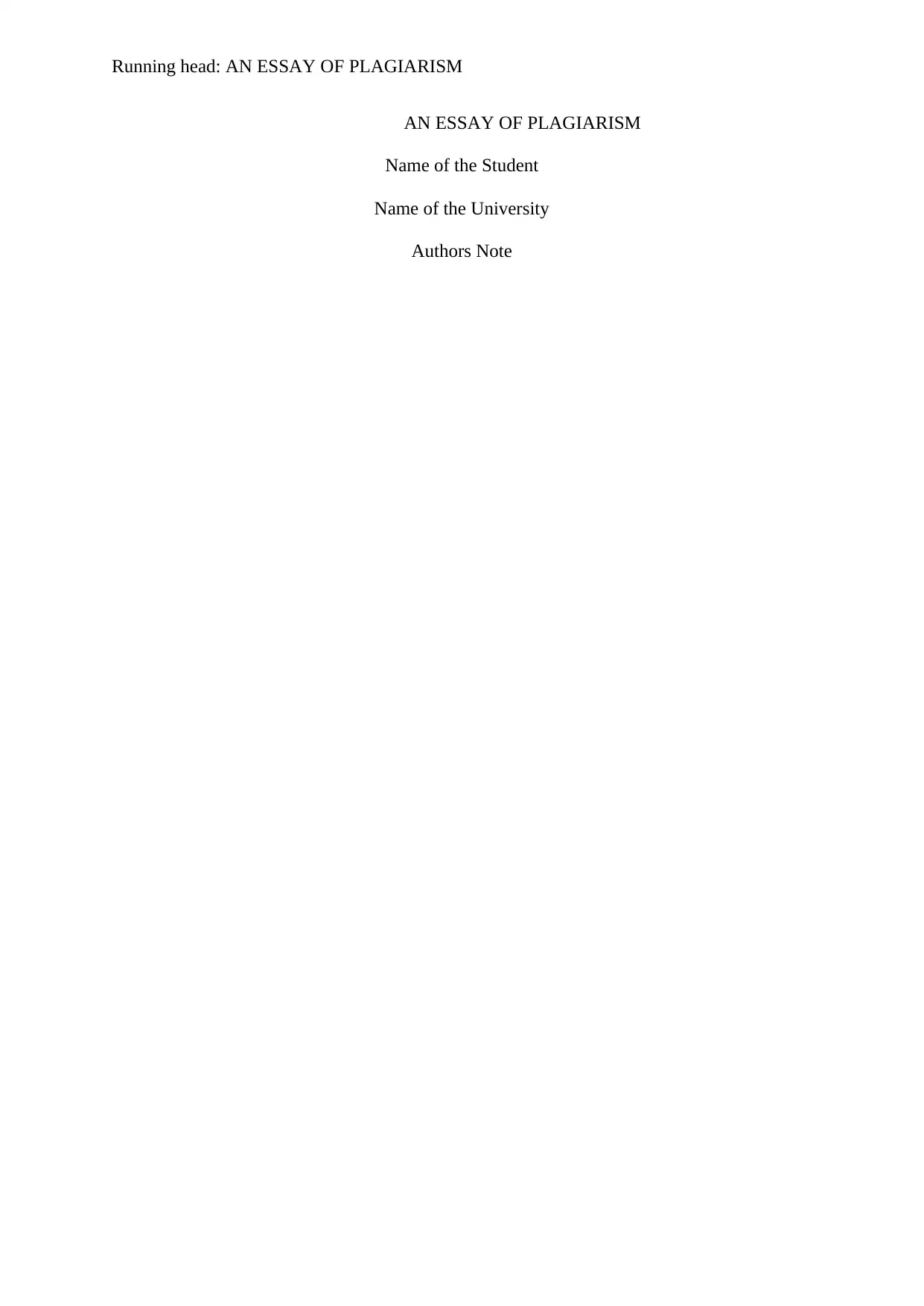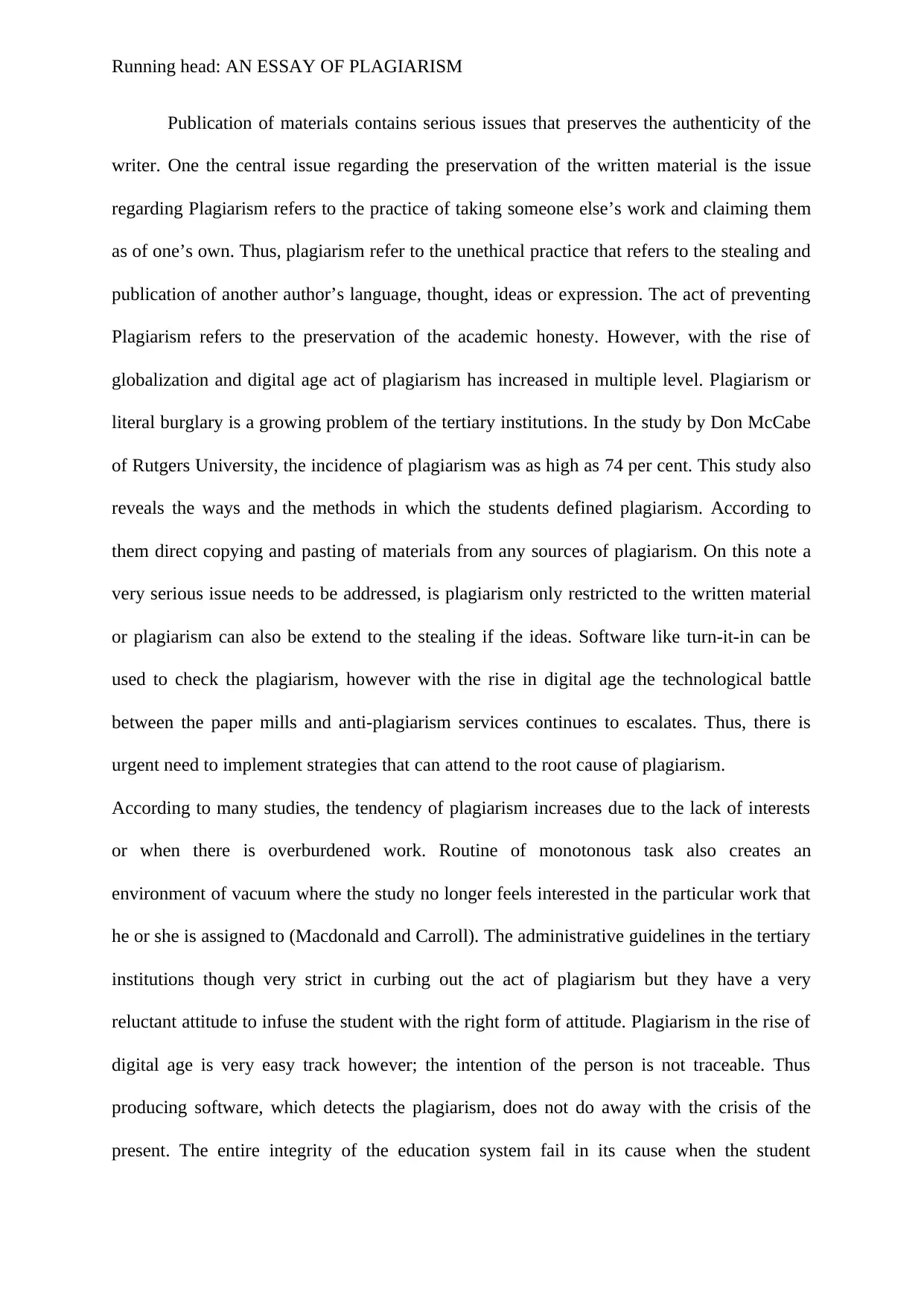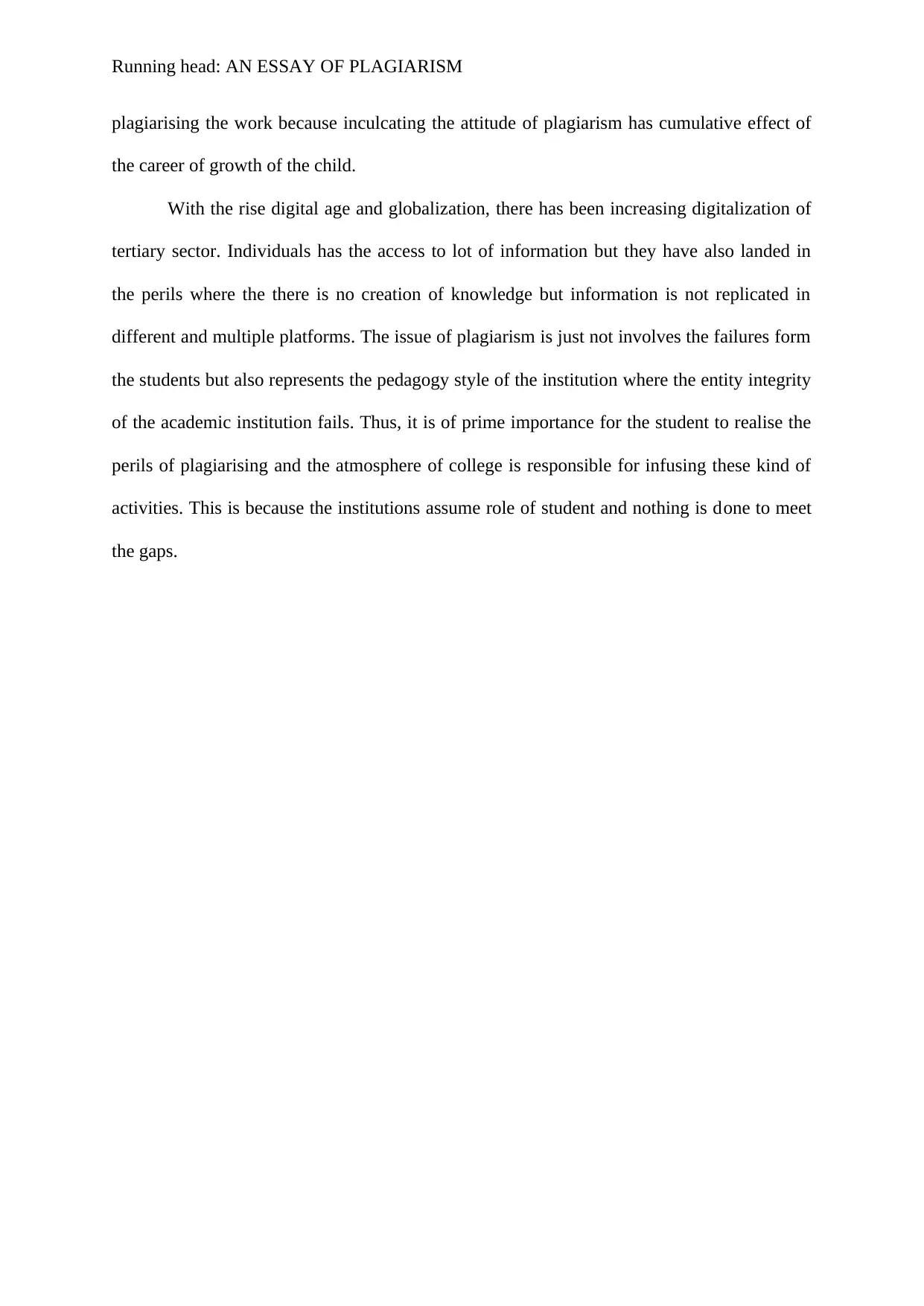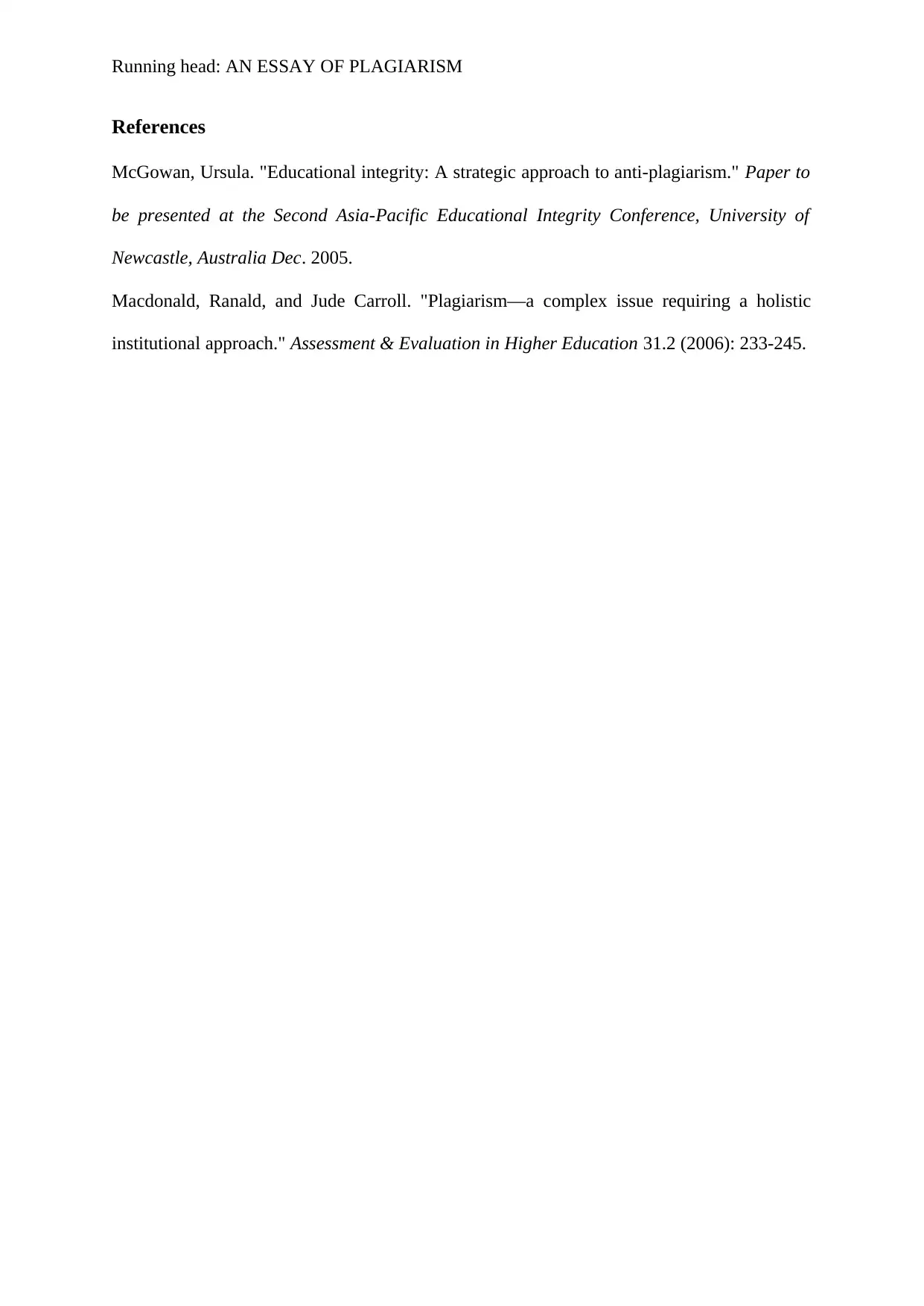Essay on Plagiarism: Causes, Effects, and Solutions
VerifiedAdded on 2023/04/08
|5
|1011
|500
Essay
AI Summary
This essay addresses the pervasive issue of plagiarism within higher education, defining it as the unethical practice of presenting someone else's work as one's own. It explores the rise of plagiarism in the digital age, citing studies that highlight its prevalence and the challenges of detection. The essay delves into the root causes of plagiarism, such as lack of interest and heavy workloads, while also critiquing the limitations of current administrative and technological solutions. It emphasizes the importance of instilling academic integrity and ethical behavior in students, highlighting the long-term consequences of plagiarism on their personal and professional development. The essay concludes by underscoring the need for a holistic approach that addresses both the student's attitude and the institutional environment to effectively combat plagiarism and promote genuine knowledge creation.

Running head: AN ESSAY OF PLAGIARISM
AN ESSAY OF PLAGIARISM
Name of the Student
Name of the University
Authors Note
AN ESSAY OF PLAGIARISM
Name of the Student
Name of the University
Authors Note
Paraphrase This Document
Need a fresh take? Get an instant paraphrase of this document with our AI Paraphraser

Running head: AN ESSAY OF PLAGIARISM
Publication of materials contains serious issues that preserves the authenticity of the
writer. One the central issue regarding the preservation of the written material is the issue
regarding Plagiarism refers to the practice of taking someone else’s work and claiming them
as of one’s own. Thus, plagiarism refer to the unethical practice that refers to the stealing and
publication of another author’s language, thought, ideas or expression. The act of preventing
Plagiarism refers to the preservation of the academic honesty. However, with the rise of
globalization and digital age act of plagiarism has increased in multiple level. Plagiarism or
literal burglary is a growing problem of the tertiary institutions. In the study by Don McCabe
of Rutgers University, the incidence of plagiarism was as high as 74 per cent. This study also
reveals the ways and the methods in which the students defined plagiarism. According to
them direct copying and pasting of materials from any sources of plagiarism. On this note a
very serious issue needs to be addressed, is plagiarism only restricted to the written material
or plagiarism can also be extend to the stealing if the ideas. Software like turn-it-in can be
used to check the plagiarism, however with the rise in digital age the technological battle
between the paper mills and anti-plagiarism services continues to escalates. Thus, there is
urgent need to implement strategies that can attend to the root cause of plagiarism.
According to many studies, the tendency of plagiarism increases due to the lack of interests
or when there is overburdened work. Routine of monotonous task also creates an
environment of vacuum where the study no longer feels interested in the particular work that
he or she is assigned to (Macdonald and Carroll). The administrative guidelines in the tertiary
institutions though very strict in curbing out the act of plagiarism but they have a very
reluctant attitude to infuse the student with the right form of attitude. Plagiarism in the rise of
digital age is very easy track however; the intention of the person is not traceable. Thus
producing software, which detects the plagiarism, does not do away with the crisis of the
present. The entire integrity of the education system fail in its cause when the student
Publication of materials contains serious issues that preserves the authenticity of the
writer. One the central issue regarding the preservation of the written material is the issue
regarding Plagiarism refers to the practice of taking someone else’s work and claiming them
as of one’s own. Thus, plagiarism refer to the unethical practice that refers to the stealing and
publication of another author’s language, thought, ideas or expression. The act of preventing
Plagiarism refers to the preservation of the academic honesty. However, with the rise of
globalization and digital age act of plagiarism has increased in multiple level. Plagiarism or
literal burglary is a growing problem of the tertiary institutions. In the study by Don McCabe
of Rutgers University, the incidence of plagiarism was as high as 74 per cent. This study also
reveals the ways and the methods in which the students defined plagiarism. According to
them direct copying and pasting of materials from any sources of plagiarism. On this note a
very serious issue needs to be addressed, is plagiarism only restricted to the written material
or plagiarism can also be extend to the stealing if the ideas. Software like turn-it-in can be
used to check the plagiarism, however with the rise in digital age the technological battle
between the paper mills and anti-plagiarism services continues to escalates. Thus, there is
urgent need to implement strategies that can attend to the root cause of plagiarism.
According to many studies, the tendency of plagiarism increases due to the lack of interests
or when there is overburdened work. Routine of monotonous task also creates an
environment of vacuum where the study no longer feels interested in the particular work that
he or she is assigned to (Macdonald and Carroll). The administrative guidelines in the tertiary
institutions though very strict in curbing out the act of plagiarism but they have a very
reluctant attitude to infuse the student with the right form of attitude. Plagiarism in the rise of
digital age is very easy track however; the intention of the person is not traceable. Thus
producing software, which detects the plagiarism, does not do away with the crisis of the
present. The entire integrity of the education system fail in its cause when the student

Running head: AN ESSAY OF PLAGIARISM
intentionally attempt for plagiarising academic materials (Ursula 2008). Plagiarism attempted
by the student’s end shows the failure of both the purpose of the educator and the institution.
However “in the end, the plagiarizer has the most to lose, whether he or she gets caught or
not”. This is because, even if he or she gets good grades and passes of the crisis moment but
this kind of activities places them a step behind. Due to the ease and the comforting nature,
the student often falls in the trap of leisure and tries to escape the every moment of the test.
Thus, the student not only defies what was expected of him, she but she or he fails to build
the attitude, or the necessary ethics which is needed to run the entire life. This kind of attitude
has a cumulative effect and there will come a day the excuses like “I am a student. I am still
learning will fail, will fall on deaf ears”. Thus, plagiarism is not only an issue, which has
short-term consequences, but it also reflects in the longer term consequences.
The use of software to detect the plagiarism is being practiced by many universities.
This kind of technological help used by the university also creates an atmosphere of the
distrust. In the digital age even though plagiarism is traceable the intentions of the person is
not traceable. The problem is not only from the student’s end. Many universities applies clear
guidelines on plagiarism but theses guideline are based on two things. One is the assumption
that the students will take initiatives to understand the information given and the second is
they are willing to develop the necessary skills, which will help them to do the assignment.
However, the reality is quite different where many students over the years have developed
ways and method to mould their writing skill. In these cases the students borrows the idea,
switches the words here and there, and claims that it is their own work. Thus, it is very
important to teach students to produce the original work instead to introducing different kinds
of restriction of plagiarism. The issue of plagiarism is very serious in the tertiary sectors but it
should also be not exaggerated because this may invite grater trouble where the student is
practicing innate indifference. It is very important to make the student realise the perils of
intentionally attempt for plagiarising academic materials (Ursula 2008). Plagiarism attempted
by the student’s end shows the failure of both the purpose of the educator and the institution.
However “in the end, the plagiarizer has the most to lose, whether he or she gets caught or
not”. This is because, even if he or she gets good grades and passes of the crisis moment but
this kind of activities places them a step behind. Due to the ease and the comforting nature,
the student often falls in the trap of leisure and tries to escape the every moment of the test.
Thus, the student not only defies what was expected of him, she but she or he fails to build
the attitude, or the necessary ethics which is needed to run the entire life. This kind of attitude
has a cumulative effect and there will come a day the excuses like “I am a student. I am still
learning will fail, will fall on deaf ears”. Thus, plagiarism is not only an issue, which has
short-term consequences, but it also reflects in the longer term consequences.
The use of software to detect the plagiarism is being practiced by many universities.
This kind of technological help used by the university also creates an atmosphere of the
distrust. In the digital age even though plagiarism is traceable the intentions of the person is
not traceable. The problem is not only from the student’s end. Many universities applies clear
guidelines on plagiarism but theses guideline are based on two things. One is the assumption
that the students will take initiatives to understand the information given and the second is
they are willing to develop the necessary skills, which will help them to do the assignment.
However, the reality is quite different where many students over the years have developed
ways and method to mould their writing skill. In these cases the students borrows the idea,
switches the words here and there, and claims that it is their own work. Thus, it is very
important to teach students to produce the original work instead to introducing different kinds
of restriction of plagiarism. The issue of plagiarism is very serious in the tertiary sectors but it
should also be not exaggerated because this may invite grater trouble where the student is
practicing innate indifference. It is very important to make the student realise the perils of
⊘ This is a preview!⊘
Do you want full access?
Subscribe today to unlock all pages.

Trusted by 1+ million students worldwide

Running head: AN ESSAY OF PLAGIARISM
plagiarising the work because inculcating the attitude of plagiarism has cumulative effect of
the career of growth of the child.
With the rise digital age and globalization, there has been increasing digitalization of
tertiary sector. Individuals has the access to lot of information but they have also landed in
the perils where the there is no creation of knowledge but information is not replicated in
different and multiple platforms. The issue of plagiarism is just not involves the failures form
the students but also represents the pedagogy style of the institution where the entity integrity
of the academic institution fails. Thus, it is of prime importance for the student to realise the
perils of plagiarising and the atmosphere of college is responsible for infusing these kind of
activities. This is because the institutions assume role of student and nothing is done to meet
the gaps.
plagiarising the work because inculcating the attitude of plagiarism has cumulative effect of
the career of growth of the child.
With the rise digital age and globalization, there has been increasing digitalization of
tertiary sector. Individuals has the access to lot of information but they have also landed in
the perils where the there is no creation of knowledge but information is not replicated in
different and multiple platforms. The issue of plagiarism is just not involves the failures form
the students but also represents the pedagogy style of the institution where the entity integrity
of the academic institution fails. Thus, it is of prime importance for the student to realise the
perils of plagiarising and the atmosphere of college is responsible for infusing these kind of
activities. This is because the institutions assume role of student and nothing is done to meet
the gaps.
Paraphrase This Document
Need a fresh take? Get an instant paraphrase of this document with our AI Paraphraser

Running head: AN ESSAY OF PLAGIARISM
References
McGowan, Ursula. "Educational integrity: A strategic approach to anti-plagiarism." Paper to
be presented at the Second Asia-Pacific Educational Integrity Conference, University of
Newcastle, Australia Dec. 2005.
Macdonald, Ranald, and Jude Carroll. "Plagiarism—a complex issue requiring a holistic
institutional approach." Assessment & Evaluation in Higher Education 31.2 (2006): 233-245.
References
McGowan, Ursula. "Educational integrity: A strategic approach to anti-plagiarism." Paper to
be presented at the Second Asia-Pacific Educational Integrity Conference, University of
Newcastle, Australia Dec. 2005.
Macdonald, Ranald, and Jude Carroll. "Plagiarism—a complex issue requiring a holistic
institutional approach." Assessment & Evaluation in Higher Education 31.2 (2006): 233-245.
1 out of 5
Related Documents
Your All-in-One AI-Powered Toolkit for Academic Success.
+13062052269
info@desklib.com
Available 24*7 on WhatsApp / Email
![[object Object]](/_next/static/media/star-bottom.7253800d.svg)
Unlock your academic potential
Copyright © 2020–2025 A2Z Services. All Rights Reserved. Developed and managed by ZUCOL.





